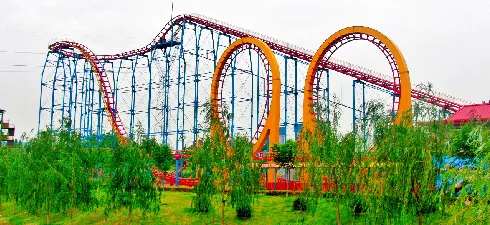- Albanian
- Arabic
- Belarusian
- Bengali
- Czech
- English
- French
- German
- Hebrew
- Hungarian
- Indonesian
- irish
- Italian
- Japanese
- kazakh
- Persian
- Russian
- Thai
- Uzbek
- Vietnamese
Ақп . 17, 2025 12:06
Back to list
rollercoaster types
Roller coasters, the heartbeat of theme parks, captivate thrill-seekers with their blend of engineering marvel and adrenaline rush. While each rollercoaster aims to deliver unique experiences, understanding the diverse types helps enthusiasts and novices alike appreciate what makes each ride special. This article delves into the different types of roller coasters, emphasizing their experience, mechanical sophistication, and enduring appeal, creating a definitive guide for enthusiasts and a valuable resource for theme park aficionados.
Suspended roller coasters differ from inverted coasters in that their trains swing side-to-side beneath the track, simulating a gliding sensation. This motion delivers a unique floating feeling as the ride curves and drops gracefully. The Big Bad Wolf, though retired, set a benchmark for such experiences, while the The Bat at Kings Island continues this legacy, providing swift movement through tree-top landscapes. These coasters thrill with their pendulum motion, creating an exciting, naturalistic flying experience. Spinning roller coasters introduce an element of unpredictability. Their cars rotate on a vertical axis, offering varied experiences on every ride as the seats spin during the journey. Prime examples, like Laff Trakk at Hersheypark and Dragon’s Fury at Chessington World of Adventures, deliver a playful and chaotic thrill that appeals to both families and thrill-seekers. The randomness of the spins adds an extra layer of excitement, making spinning coasters an innovative choice in the current amusement ride scene. Flying roller coasters, where riders are positioned face-down, emulate the sensation of soaring through the air. This unique arrangement offers a layered experience of gliding and diving. Coasters like Tatsu at Six Flags Magic Mountain and Manta at SeaWorld Orlando showcase breathtaking maneuvers that simulate flying. The engineering expertise behind these coasters ensures a seamless switch from upright seating to a horizontal position, highlighting the ride’s thrilling demands on both body and mind. Lastly, the launch roller coaster, utilizing magnetic propulsion instead of traditional lift hills, catapults riders to high speeds in seconds. This powering mechanism allows for quick acceleration, providing a jolt of energy right from the start. Maverick at Cedar Point and Intimidator 305 at Kings Dominion exemplify this adrenaline-fueled type. Riders are guaranteed explosive beginnings paired with daring elements and swift maneuvers, redefining the conventional expectations of coaster escalation. In conclusion, each type of roller coaster offers distinct thrills driven by innovative engineering and immersive experiences. Whether a fan of stomach-flipping drops or graceful glides, understanding these roller coaster types enriches the ride experience and provides insight into the artistry of amusement park attractions. For parks and designers, constantly pushing the boundaries of what a roller coaster can achieve, these diverse designs ensure lifelong fans and a future bursting with innovative approaches to exhilaration.


Suspended roller coasters differ from inverted coasters in that their trains swing side-to-side beneath the track, simulating a gliding sensation. This motion delivers a unique floating feeling as the ride curves and drops gracefully. The Big Bad Wolf, though retired, set a benchmark for such experiences, while the The Bat at Kings Island continues this legacy, providing swift movement through tree-top landscapes. These coasters thrill with their pendulum motion, creating an exciting, naturalistic flying experience. Spinning roller coasters introduce an element of unpredictability. Their cars rotate on a vertical axis, offering varied experiences on every ride as the seats spin during the journey. Prime examples, like Laff Trakk at Hersheypark and Dragon’s Fury at Chessington World of Adventures, deliver a playful and chaotic thrill that appeals to both families and thrill-seekers. The randomness of the spins adds an extra layer of excitement, making spinning coasters an innovative choice in the current amusement ride scene. Flying roller coasters, where riders are positioned face-down, emulate the sensation of soaring through the air. This unique arrangement offers a layered experience of gliding and diving. Coasters like Tatsu at Six Flags Magic Mountain and Manta at SeaWorld Orlando showcase breathtaking maneuvers that simulate flying. The engineering expertise behind these coasters ensures a seamless switch from upright seating to a horizontal position, highlighting the ride’s thrilling demands on both body and mind. Lastly, the launch roller coaster, utilizing magnetic propulsion instead of traditional lift hills, catapults riders to high speeds in seconds. This powering mechanism allows for quick acceleration, providing a jolt of energy right from the start. Maverick at Cedar Point and Intimidator 305 at Kings Dominion exemplify this adrenaline-fueled type. Riders are guaranteed explosive beginnings paired with daring elements and swift maneuvers, redefining the conventional expectations of coaster escalation. In conclusion, each type of roller coaster offers distinct thrills driven by innovative engineering and immersive experiences. Whether a fan of stomach-flipping drops or graceful glides, understanding these roller coaster types enriches the ride experience and provides insight into the artistry of amusement park attractions. For parks and designers, constantly pushing the boundaries of what a roller coaster can achieve, these diverse designs ensure lifelong fans and a future bursting with innovative approaches to exhilaration.
Latest news
-
Inside Ferris Wheel Cabins Premium Comfort & Safety FeaturesMay.21,2025
-
Mad Mouse Roller Coaster Rides Compact Thrills & Family Fun OfficialMay.21,2025
-
S&S Roller Coasters Thrilling Rides & Innovative DesignsMay.20,2025
-
Premium Log Flume Rides for Sale Trusted Flume Ride ManufacturersMay.20,2025
-
King Kong Roller Coaster in China Thrilling Theme Park Adventure 2024May.20,2025
-
Steel Pier Observation Wheel 360° Waterfront Views & Durable DesignMay.19,2025
